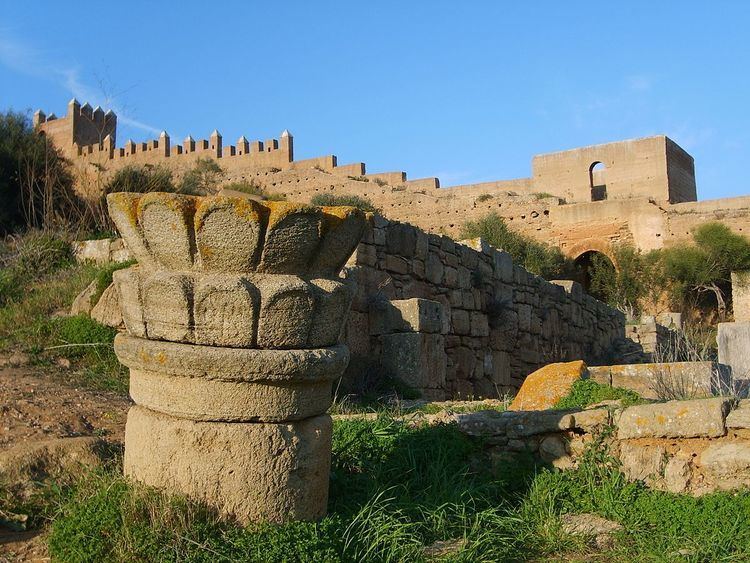Type Necropolis | Abandoned 1154 AD Phone +212 642-460078 | |
 | ||
Alternate name Sala Colonia (name of Roman colony) Hours Open today · 8:30AM–6:30PMSaturday8:30AM–6:30PMSunday8:30AM–6:30PMMonday8:30AM–6:30PMTuesday8:30AM–6:30PMWednesday8:30AM–6:30PMThursday8:30AM–6:30PMFriday8:30AM–6:30PM Similar Hassan Tower, Kasbah of the Udayas, Mausoleum of Mohamm, Andalusian Gardens, Mohamed VI Museum of Moder Profiles | ||
Chellah power music video
The Chellah (Berber: Calla or Sla; Arabic: شالة, Shillah), is a medieval fortified Muslim necropolis located in the metro area of Rabat, Morocco, on the south (left) side of the Bou Regreg estuary. The Phoenicians established a trading emporium at the site and called it "Sala". This was later the site of the ancient Roman colony of "Sala Colonia", in the Roman province of Mauretania Tingitana.
Contents
- Chellah power music video
- Chellah ooouuu remix music video
- Phoenician and Punic Sala
- Roman Sala Colonia
- Muslim Sal
- Festival of Jazz
- World Heritage Status
- References
Salā was the name given to the city founded by the Muslim conquerors of North Africa, which was mostly abandoned during the Almohad era, then rebuilt by the Marinids in the 13th century. The ruins of their medieval fortress are still extant. The Berber Almohads used the site as a royal burial ground. The Marinids made the site a holy necropolis, or chellah, and built a complex that included mosque, minaret, and royal tombs. The tall minaret of the now-ruined mosque was built of stone and zellige tilework, and still stands.
Contrary to legend, the corsairs of Salé did not actually operate out of Salé (called "Old Salé"), but out of the city that would later become known as Rabat, ("New Salé") on the south (left) bank of the Bou Regreg.
Chellah ooouuu remix music video
Phoenician and Punic Sala
The Phoenicians founded several colonies in what is now Morocco and built a settlement they called "Sala" on the banks of the Bou Regreg river that their Carthaginian successors occupied as well.
Roman Sala Colonia
The Romans later built their own city, Sala Colonia, very near the same site. The Roman town was referred to as "Sala" by Ptolemy. Excavations show a substantial port city with ruined Roman architectural elements including a decumanus maximus or principal roadway, a forum and a triumphal arch. Sala was a center of Christianity since the 2nd century.
One of the two main Roman Roads in Mauretania Tingitana reached the Atlantic through Iulia Constantia Zilil (Asilah), Lixus (Larache) and Sala Colonia. Another may have been built towards the south, from Sala to modern Casablanca, then called Anfa. The Romans had two main naval outposts on the Atlantic coast of the province: Sala Colonia, and Lixus. The port of Sala (now disappeared) was used by commercial Roman ships as a way station on their southwestward passages to Anfa and the Insula Purpuraria (Mogador island).
Sala remained linked to the Roman Empire even after the withdrawal in the 4th century of the occupying Roman legions to Tingis and Septem in northern Mauretania Tingitana. A Roman military unit remained there until the end of the 5th century. Archaeological objects of Visigothic and Byzantine origin found in the area attest to the persistence of commercial or political contacts between Sala and Roman Europe, up to the establishment of a Byzantine presence in Berber North Africa during the 7th century.
Muslim Salā
Sala continued to exist as a town of the Christianized Berbers, but was mostly in ruins when the Muslim Arabs arrived in the 7th century. The Byzantine governor of the area, Count Julian of Ceuta, surrendered to Uqba ibn Nafi in 683. Around 1030, the town of Salā was founded at the site by the Banu 'Ashara family. With the extinction of the Umayyad dynasty in 1031, the Almoravids assumed control of the Maghreb (present-day Tunisia, Algeria, Morocco) and erected new buildings in Salā. They rebuilt the Great Mosque of Salā on the site of the mosque of the Banu 'Ashara, completing it in 1196.
By 1147, the Almoravids had been overthrown by the Berber Almohads, who used the site as a royal burial ground. It was made a sacred necropolis, or chellah, by the Marinids in the 13th century; the Muslim sanctuary complex of mosque, minaret, and royal tombs being built by Abu Yusuf Yaqub, and finished in 1284. His remains were moved to the necropolis after he died at Algeciras in 1286. The tall minaret of the now-ruined mosque was built of stone and zellige tilework, and still stands. Near the minaret is the tomb of the Maranid ruler, Abu al-Hasan Ali ibn Othman, known as the Black Sultan.
Many of the remaining structures in Chellah were damaged by the 1755 Lisbon earthquake. The site has been converted to a garden and tourist venue, and today it is included in the metropolitan area of Rabat.
Festival of Jazz
Since 2005, the ruins of Chella host an international "Festival of Jazz" each year, called Jazz au Chellah.
World Heritage Status
The site, as part of the metropolitan Rabat, was granted World Heritage Status in 2012.
